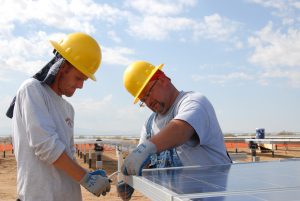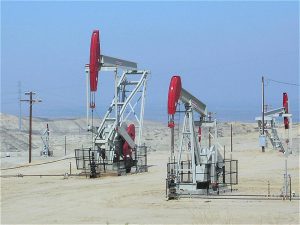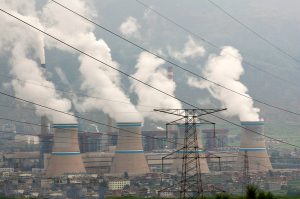Saudi Prince talks of his nation’s “dangerous addiction” to oil, and sets out a plan to kick dependency within just a few years. Elon Musk, arguably the most successful entrepreneur ever, turns the unveiling of an electric car not due to be delivered for 18 months into the most successful product launch in history.
A revered Silicon Valley futurist ponders the seven doublings of the global solar market since 2000 – one roughly every two years – and advises doubters in the technology not to ignore the arithmetic of exponential growth: six more doublings over the next 12 years would mean 100% of global energy from the sun.
Plus much more that would have been scarcely imaginable a year ago.
That was April in the great global energy transition.
None of it is guaranteed to materialise. That’s the thing about narrative tension. In my book, given the stakes, no novel can rival this epic real-life drama.
Apropos the stakes, Presidents Obama and Xi exhorted nations to sign the Paris Agreement with them on Earth Day, and 169 did: a record for any treaty on its first day for signature. In America, a tide may be turning: record numbers now worry about climate change (64%) and support renewable energy. Of Republicans, 61% support the regulation of carbon dioxide, and 72% support acceleration of renewables.
Of the 1,000 cities committed to 100% renewable energy, San Diego is a leader, with a target of 2035, and its mayor is a Republican. San Francisco became the first of the 100% cities to make solar mandatory on all new buildings.
Hewlett Packard became the latest recruit to the 50-plus companies committed to 100% renewables. IKEA, the front runner with a target of 100% renewable energy by 2020, declared its intention to be number-one global solar retailer, and soon thereafter announced a UK partnership with Solarcentury, the first company to install 500 megawatts of solar under the grey skies of the UK. (Declaration of interest: I founded Solarcentury and am a significant shareholder).
Tesla unveiled its US$35,000 Model 3 EV on 31st March. By 3rd April, Elon Musk’s company had taken 276,000 orders worldwide, with queues of people outside its stores waiting to table US$1,000 deposits. Orders now exceed 400,000, meaning more than US$10 billion of sales on Day One, should all deposits become orders and were the company able to manufacture enough vehicles. Not to mention US$400 million of free money for Tesla in the 18 months before the first scheduled delivery. No previous product has come remotely close to this reception.
How will these EVs, and all the others like them, be powered? Around the world, solar and wind are already “crushing” fossil fuels, Michael Liebreich of Bloomberg observed this month. And as costs continue to plunge, the list of places where these two renewables are cheaper than incumbency options has only just started to be written.
Where might it end? Silicon Valley futurist, Ray Kurzweil, calculated that six more doublings of the global solar market at the same pace of the past would mean 100% of global energy from solar within just 12 years. The bankruptcy of a leading solar player in April, SunEdison, is being widely ascribed to an overexuberant business model: a blip on the upward megatrend.
The Saudi leadership is watching closely, it seems. On April 26, Deputy Crown Prince Mohammed bin Salman announced details of the US$2 trillion post-oil-era fund he had unveiled in March. “We have an addiction to oil,” he said. “This is dangerous.” It could be ended by 2020 by investing in other areas of the economy that have been historically neglected, according to his “Vision 2030” plan.
A renewables target of 9.5 gigawatts (GW) by 2030 will disappoint clean-energy enthusiasts, given that a cloudy nation such as the UK already has more than 9 GW capacity of just solar, and experienced its first day of solar providing more electricity than coal in April.
The level of Saudi ambition will undoubtedly leap, given the world records being set in solar auctions, and ambitious plans elsewhere. In India, where the government acknowledges that solar is now cheaper than coal, the national solar target is 100 gigawatts by 2020.
All this intensifies the risk of stranded assets in fossil-fuel reserves, and wastage of capital in Big Energy capex programmes. Many in the financial sector are avidly awaiting the deliberations of the G20 taskforce on climate-risk financial disclosure chaired by Michael Bloomberg. Its interim report, on 4th April, points squarely to new financial reporting of a kind that will mainstream appreciation of climate risk and fuel the flight of capital from fossil fuels.
Fossil fuel industries feel the pinch
Meanwhile the evidence of incumbency giants wasting value by miscalculating the risks of fossil-fuel addiction builds remorselessly. Peabody, America’s biggest coal miner, went bankrupt in April.
ExxonMobil had its triple-A credit rating downgraded for the first time since the 1920s. Shale drillers found their credit lines slashed by banks everywhere. More than 50 shale drillers have gone bankrupt. In the famous Barnett Shale, where the short-lived shale boom started, the drill rig count fell to zero.
This is the same shale industry that David Cameron, George Osborne and their followers hope to replicate in the UK. They will find it difficult, even if they can magic away the ruinous economics of shale. A new government opinion poll put support for shale gas at a record low of 19%, against a record high of 81% for renewables, with only 4% opposed.
Slow dime rather than fast nickel
One of the many reasons the US shale industry will find it difficult to ramp up again, even if the oil price soars back above US$100, is that its workers are fleeing the industry. A Wall Street Journal headline told the story on April 21. “As Oil Jobs Dry Up, Workers Turn to Solar Sector.” Said one worker: “My grandfather always said it’s better to make a slow dime than a fast nickel.”
Then there is the issue of methane leakage from gas infrastructure and operations, which emerging monitoring suggests is particularly bad in the US shale regions. Many now fear this problem renders gas a bigger cause of global-warming than coal. The US Environmental Protection Agency admitted in April that leakage is far worse than they thought, and NOAA fuelled the concerns with new data gathered in aerial surveys.
Legal victory
The courts are taking an ever closer interest right across the climate-energy nexus. An Oregon judge ruled in favour of schoolchildren suing the federal government for violating their constitutional rights to life, liberty and property, because central government authorities had permitted, encouraged and otherwise enabled continued exploitation, production and combustion of fossil fuels.
Meanwhile, US Attorneys General continue to investigate ExxonMobil for securities fraud, suspecting the oil giant consciously lied to shareholders about climate risk.
Everywhere one looks in the great global energy transition, the plot thickens.
This article was originally published on www.jeremyleggett.net.







